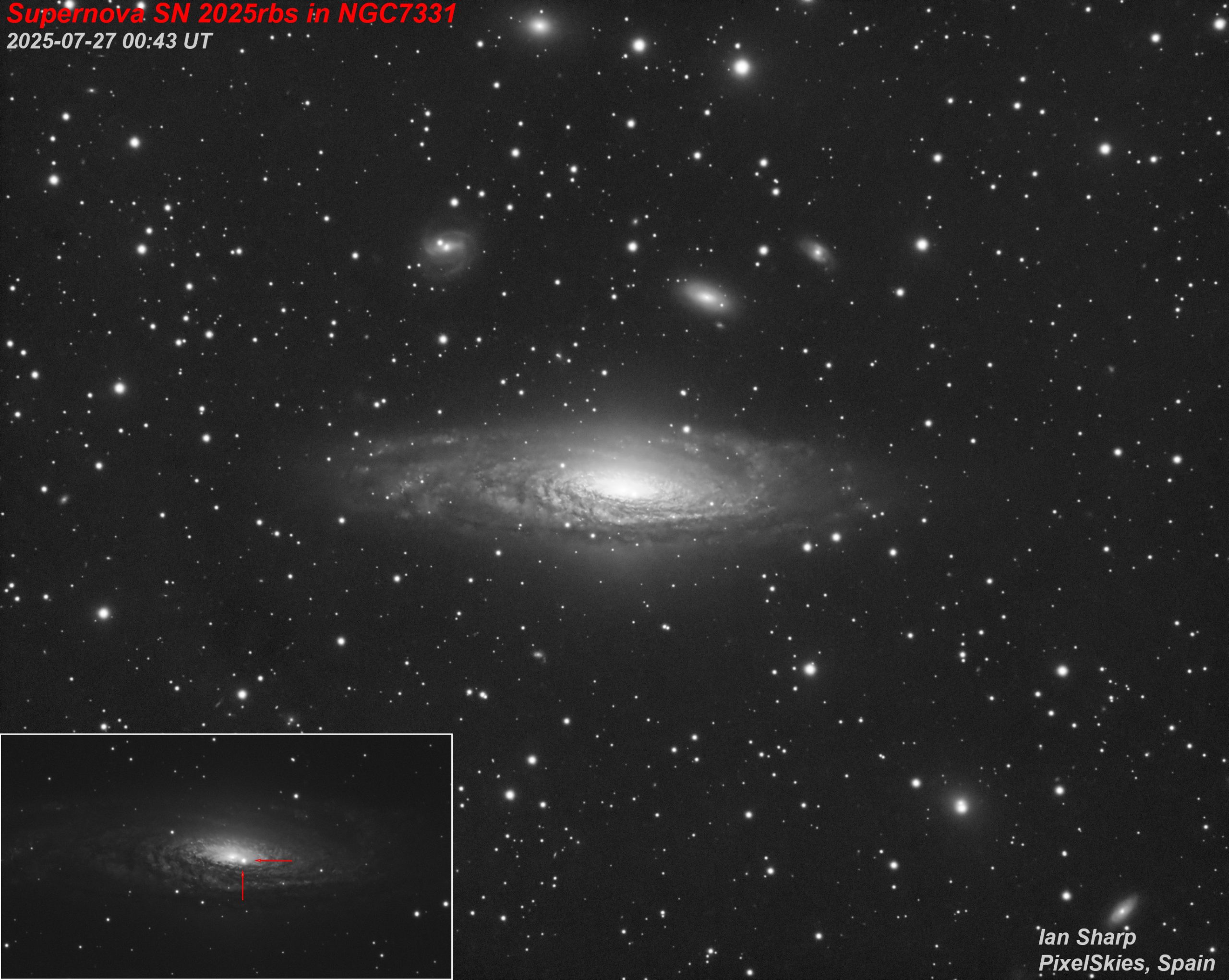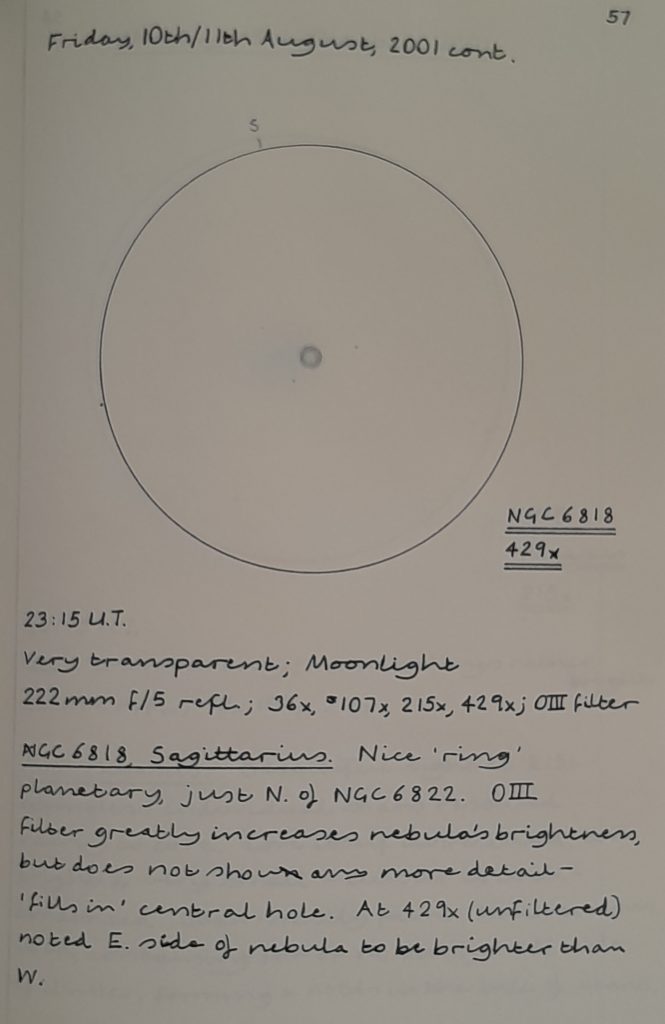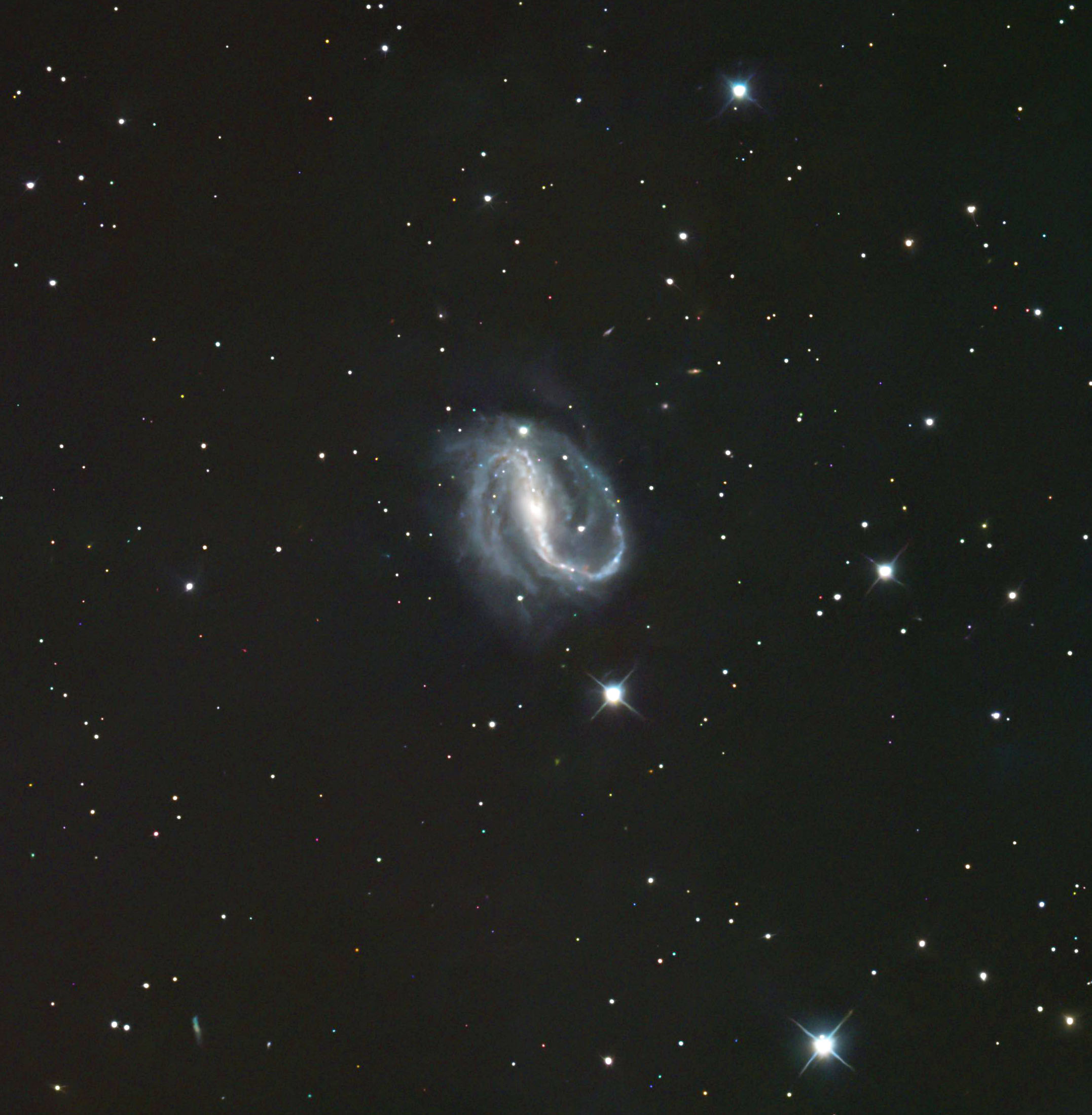2025 August 5
Deep Sky Update – July 2025
Sorry, another late update – I had good intentions to start this update several days ago, but events overtook. July night skies have been bright again, but I did see a star (Vega) a couple of nights ago. We have luckily not been affected by the internet outage to the northern isles, we must be on another leg of cable. And although it was a bit windy yesterday with Strom Floris we don’t seem to have suffered even though local weather stations were reporting gusts to 72 mph.
Section Meeting 2026
Plans are progressing well for the section meeting in 2026. The Cotswold Astronomical Society are kindly hosting the meeting and we are just finalising the venue. For those that have attended our meetings in Cheltenham in the past, the venue will be new – their current venue is too small and the previous venue is unavailable. March 28th is the date. If anyone would like to give a talk or short talk please let me know.
Supernova in NGC 7331
The supernova SN 2025rbs has been well observed by members. It was about mag. 16 on discovery and is currently about mag. 12 putting it in range of visual observers. Jim Latham reported “I managed to catch it on 24 July and it was impressive, easily seen and giving the impression of a double nucleus.”
One of my favourite galaxies, it is known as the Deer Lick Galaxy, and is accompanied by many companion galaxies known as the Fleas.
This image of NGC 7331 and the supernova was taken by Ian Sharp.
Argus3 Citizen Science Project
Here is a message from Grant Privett about this project which many deep sky observers will be equipped to participate in. Get in touch with me and I will forward onto Grant.
Some of you may know my name, as I have been a BAA member on and off since the 1970s. However, this project is being run by the Defence Science and Technology Laboratory – a UK Government Agency where I work as a Civil Servant. We undertake scientific research and assessment projects for the MOD and other Government departments, including the UK Space Agency.
I am contacting you in the hope that we may be able to involve some of the BAA’s more skilled observers in an interesting research project that will look at the utility of commercial-off-the-shelf equipment in the observation of spacecraft operating beyond the geostationary orbit. The intent is to increase our understanding of small telescope performance and thereby allow us to rapidly whittle down the options for fulfilling the UK Government’s space cataloguing needs, while minimising the cost to tax-payers.
The plan is to ask volunteers to attempt to observe satellites/probes objects travelling beyond the geostationary belt in transfer orbits, satellites resident at the Moon or travelling to/from beyond the Earth-Moon system. The hope is to discover what sort of telescope specification is required to fulfil our UKSA/MOD surveillance of space needs and to ensure we understand what is going on in space. We could model all this but the effect of dust on optics, thin high cloud, sky gradients/light pollution, poor flat fielding and optical baffling make it more realistic to use real world measurements.
We propose to set up a 60 minute Teams meeting one evening where we present the plan and invite members to engage with us and take some images to image a few chosen targets to a good accuracy – especially in proximity to the Moon. In previous projects many volunteers provided some data but soon dropped out, but those who kept going would be asked to spend time looking at a lunar lander in the autumn.
Alas, we cannot pay anyone for their time and it would be on a volunteer basis only. However, we do provide an unusual challenge and opportunities for enhanced interaction with skilled observers with similar interests.
For background, a few years ago we ran a couple of similar Citizen Science projects looking at how DSLRs and small telescopes might be best exploited in the observation of a low Earth orbit satellite (Remove Debris) and also satellites docking in the geostationary belt (Intelsat and MEV2). That activity was undertaken with some observers from Tamworth Region Astronomical Club in Australia and also a few members of the Basingstoke Astronomical Society. It was pretty successful and ended up being the subject of a NAM presentation, an Astronomy Now article, a paper in the proceedings of the AMOStech conference (https://amostech.com/TechnicalPapers/2019/Space-Situational-Awareness/Feline.pdf) and various radio and newspaper items. More importantly, it gave us a strong understanding of what could be accomplished with minimally expensive equipment, which assisted us greatly in our advice-giving role to UKSA.
The difference this time is that, once you get beyond the geostationary belt, the satellites are faint and it becomes rather more demanding of equipment, planning and observer skill. That said, we’re not setting an aperture limit – if you can image the JWST you can probably image some satellites most of the way to the Moon. Obviously, aperture is useful as – for example – CubeSats at the lunar distance are approximately 19th magnitude – though objects like Artemis were much brighter at 16-17th.
We hope to start the project with the Griffin probe in the 4th quarter of this year. But would first get people practicing on targets like Spektr-R which is in a Molniya orbit or the JWST which is at the Lagrange point.
Double Stars for August – Peter Morris
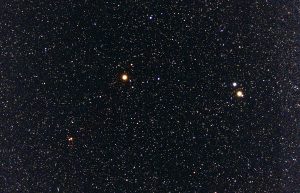
This month I will discuss four doubles in Delphinus. Gamma Delphini (STF 2727) is a showcase double and presents an interesting colour contrast. However, as I discuss it in the latest issue of Popular Astronomy I will pass over it here. There is a nice dim double 15 arcminutes directly below Gamma Delphini called STF 2725. The stars are magnitude 7.5 and 8.2, a neat separation of 6.2 arcseconds and a position angle of 11.6°. They are usually seen as yellow and blue. The problem is that it is badly affected by the glare from Gamma Delphini and is best observed while looking at Gamma itself. It is a binary system with a long period of 2,108 years.
My second double is a miniature asterism, namely STF 2703. The three stars are all similar in brightness, 8.4, 8.4 and 8.8. Two of them are close (25.1 arcseconds, position angle 290°) and the third dimmer one is more distant (77,8 arcseconds, position angle 233.5°). This triple looks like a tiny jet plane (or a paper dart) flying between two bright stars, Beta Delphini and Zeta Delphini. They are all white. The AB pair is a binary system, but the AC pair is an optical double.
Another easy dim pair is STF 2690, which is near the “tail” of the Dolphin (Epsilon Delphini). The stars are magnitude 7.1 and 7.2; the separation is 17.8 arcseconds and the position angle is 254.8°. They are both white.
Kappa Delphini (STT 533) is below the tail in the direction of Equuleus. The main star is magnitude 5.2 and there is a secondary fairly nearby (46.3 arcseconds, position angle 278.2°) but it is a faint optical double (mag. 11.6). The AC pair is very wide (214.6 arcseconds, position angle 100.8°), but it is a binary system. As in the case of Gamma Delphini, the main interest lies in the colours. Kappa Delphini is a G type star and C is a K type. I suppose in principle they could be seen as a yellow-white and yellow pair, but it is usually reported as being yellow-white or yellow and a colour which is difficult to pin down. Kepple and Sanner say that it is reddish. Smyth called it lilac (and the main star as white). Eventually I settled on blue. The problem with the colour of the secondary (which is seen as a wide range of colours from purple through red to blue or yellow) arises because the secondary is cooler (more yellow) than the primary. Why this colour issue arises is not known, but it is clearly connected to the human eye not the star. The most famous example of this contrast is Achird (Eta Cassiopeiae) which is sometimes called the “Easter Egg” double because it is seen as yellow and purple.
July Object of Interest – NGC 6818
The “Little Gem” planetary nebula NGC 6818 in Sagittarius was July’s target. Perhaps the weather or location was not conducive, but I only got this one image from Jonathon Elliott.
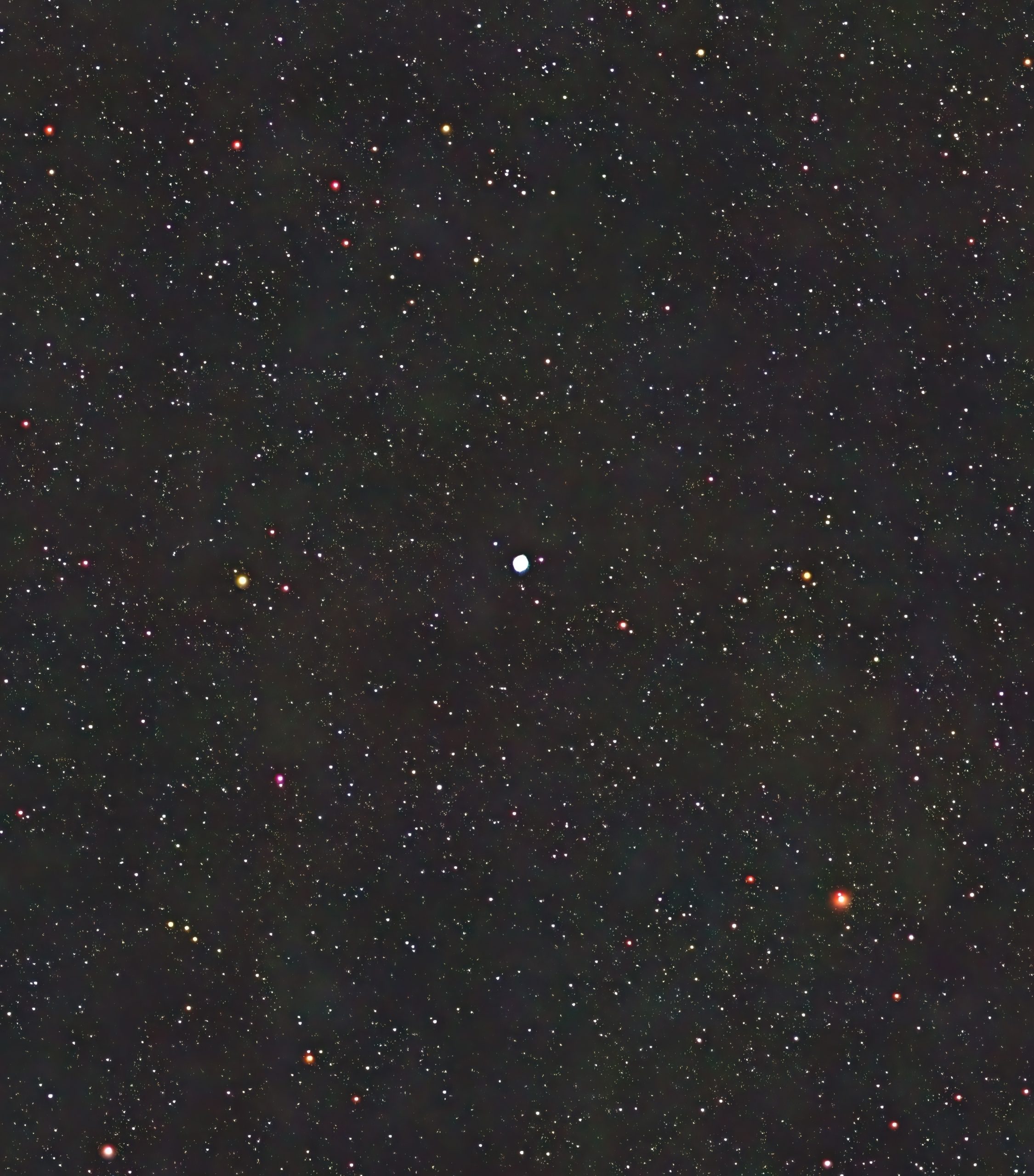
https://britastro.org/observations/observation.php?id=20250709_123353_8f3fece0435f5ffc
Lee MacDonald scoured his archives and found a couple of observations and this nice sketch.
Lee writes:
“I first observed this planetary nebula in 1993, when I used a 222mm reflector. I found it instantly recognisable at 65x, with a distinct disc. Higher powers showed its ring shape.
By the time of my 2001 observation, I had a Lumicon OIII filter (purchased in 1995). Observing with the same size of telescope, I found that the OIII filter greatly increased the nebula’s brightness, but did not show any more detail – indeed, it ‘filled in’ the nebula’s central hole.
NGC 6818 is a beautiful yet under-observed planetary nebula. The fact that it is in Sagittarius should not put off British observers: it is in the north-east corner of that constellation and rises high enough for a reasonable view, at least from southern England.
Much more difficult is the nearby galaxy NGC 6822. I could just see it in August 1993, the same night as I observed NGC 6818. In September 1994, I went to observe this galaxy again, with the same 222mm reflector, but only suspected its presence, despite the sky being clear enough for the Veil Nebula NGC 6992 to be easily visible overhead. I definitely saw it again in 2001. Both then and in 1993, it was large and very faint: knowing its exact position in advance was essential. Given the difficulty I had seeing it in 1994, its visibility is also strongly dependent on sky transparency.”
If you did not get it in July please try in August – it should still be available.
Object of Interest for August
Jim Latham has kindly picked another target for August – indeed one that is new to me!
It is the open cluster Pismis Moreno 1 and the associated emission nebula Sharpless 2-140 in Cepheus. The cluster should not be too hard for visual observers but the nebula may be hard. Both should be good to image.
Deep Sky Picture of the Month
Lots of excellent targets imaged in July – I have always liked the ‘Superman Galaxy’ NGC 7479 and this is an excellent rendition by David Strange.
And Finally
I’m looking forward to dark skies arriving in a couple of weeks – I hope the weather will cooperate. And wherever you are I hope you get some good observing.
Clear, dark skies
Callum
| The British Astronomical Association supports amateur astronomers around the UK and the rest of the world. Find out more about the BAA or join us. |

